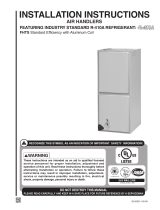
5
4. Turn the gas control knob to the
“OFF” position, or depress the gas
control lever and move to the
“OFF” position.
5
. Replace the control door.
SEQUENCE OF OPERATION
Single Stage Thermostat
1. When there is a call for heat the
furnace runs a self check routine
to verify that the contacts on the
pressure switches are open. The
limit switches are constantly
monitored.
2. The induced draft motor starts on
high for a few seconds to assure
that the low pressure switch
closes and then changes to low
speed. It will continue to run for a
thirty second prepurge.
3. The spark ignitor is energized and
the low stage of the gas valve
opens, lighting the burners.
4. After the gas valve opens, the
remote sensor must prove ignition
for one second.
5. The main blower starts on low
speed 30 seconds after the gas
valve opens. The furnace will
operate on low fire for 12 minutes
and then, if the thermostat is not
satisfied, shift to high fire. This will
cause the draft inducer to go to
high speed and the main blower
will go to heat speed. The induced
draft motor will continue running
for a 5 second (low speed) or 10
second (high speed) post purge.
The main blower will run for 90
seconds on high speed or 120
seconds on low speed.
Sequence if system doesn’t light or
sense flame
1. If flame is not sensed within 8
seconds after the gas valve
opens, the valve closes and the
ignitor is de-energized.
2. The induced draft motor will run
for 60 seconds on low, stop
momentarily, and then restart.
3. The ignition process will go
through one more try on low fire. If
this fails, there will be two tries on
high fire with a 30 second
interpurge between trials. If there
is no ignition after the 2nd trial on
high fire, the furnace will go into
soft lockout for one hour.
4. The sequence will repeat after a
one hour delay and continue
repeating until ignition is
successful or the call for heat is
terminated.
5. To reset the lockout, make and
break power either at the
thermostat or at the unit
disconnect switch for 5 to 10
seconds. The furnace will then go
through another set of trials for
ignition.
Two Stage Thermostat
Connect W1 and W2 terminals on the
thermostat to W and W2 terminals on
the control board.
Call for 1st stage heat
1
. When there is a call for heat the
furnace runs a self check routine
to verify that the contacts on the
p
ressure switches are open. The
limit switches are constantly
monitored.
2. The induced draft motor starts on
high for a few seconds to assure
that the low pressure switch
closes and then changes to low
speed. It will continue to run for a
thirty second prepurge.
3. The spark ignitor is energized and
the low stage of the gas valve
opens, lighting the burners.
4. After the gas valve opens the
remote flame sensor must prove
ignition for one second.
5. The main blower will start on low
speed 30 seconds after the gas
valve opens. The furnace will
continue to operate on low fire
until the call for heat is satisfied or
the second stage contacts close.
6. If the 1st stage call for heat is
satisfied the gas valve will close
and the induced draft motor will
continue running for a 10 second
post purge. The main blower will
run for 90 seconds.
Call for 2nd stage heat after 1st
stage
1. R and W2 thermostat contacts
close, calling for 2 stage heat.
2. The induced draft motor then
switches to high speed and the
high pressure switch contacts will
close, allowing the gas valve to
switch to high fire and the main
blower to switch to heating speed.
2nd stage heat satisfied, 1st stage
heat still required.
1. R and W2 thermostat contacts
open.
2. The induced draft motor switches
to low fire and the main blower
motor switches to low speed. The
furnace will continue to run in this
mode until the 1st stage heat call
is satisfied. The system will shut
down as noted in “6”, under 1st
stage call for heat.
NOTE: Under extreme cold conditions,
the 2-stage thermostat may call for the
furnace to cycle between 1st and 2nd
stage operation.
OPERATING INSTRUCTIONS
(DIRECT SPARK IGNITION
SYSTEM)
1. STOP! Read all safety informa-
tion.
2. Set the thermostat to the lowest
setting.
3. Turn off all electric power to the
appliance.
4. This appliance does not have a
pilot burner. It is equipped with an
ignition device which
automatically lights the burner. Do
not
try to light the burner by hand.
5. Remove control door.
6. Turn the gas control knob
clockwise to “OFF” position.
7. Wait five (5) minutes to clear out
any gas. If you then smell gas,
STOP! Follow ‘B’ in the safety
information above. If you don’t
smell gas, go to the next step.
8. Turn on the gas to the main
burners by turning the gas control
knob counterclockwise to the
“ON” position.
9. Replace the control door.
10. Turn on all electric power to the
appliance.
11. Set the thermostat to the desired
setting.
12. If the appliance will not operate,
follow the instructions “To Turn
Off Gas To The Appliance” and
call your qualified installer, service
agency or the gas supplier.
TO TURN OFF GAS TO THE
APPLIANCE
1. Set the thermostat to the lowest
setting.
2. Turn off all electric power to the
appliance if service is to be
performed.
3. Remove the control door.
FIGURE 3
T
YPICAL DIRECT SPARK IGNITION
G
AS VALVE
Manual gas
control
switch
shown in
“ON”
position.









